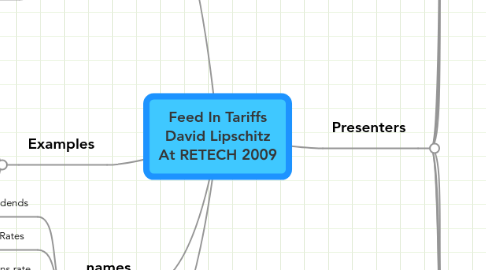
1. Louis
1.1. the Alliance for Renewable Energy
1.2. lead the panel
2. names
2.1. RED's: RE Dividends
2.2. RER: RE Rates
2.3. In Germany Tariff means rate
2.4. An RPS and a FIT go together
2.4.1. the RPS is used to set the FIT
2.5. Energy Security
2.5.1. [what is the cost of being out of action for 4 days per year, or for 4 hours unexpectedly at any time?]
3. Examples
3.1. Ontario
3.1.1. $.42 per kwh
3.2. USA
3.2.1. From the bottom up
3.2.2. Florida
3.2.2.1. $.32/kwh
3.2.2.1.1. replaces both rebate and net metering
3.2.2.2. 4MW per year
3.3. Germany
3.3.1. 100% goes into the grid
3.3.2. $1.34 per kwh in Aachen in 1993
3.3.2.1. Gainsville in Florida only doing this in 2009
4. principles
4.1. utility must connect anyone to the gird
4.2. they must buy all the energy that is produced
4.3. 15 to 20 year contracts
4.4. must buy at a fixed price for the length of the contract
4.5. prices vary (differentiated) according to
4.5.1. type of technology
4.5.2. size of system
4.5.3. by application, fuel, resource
4.6. how do you ensure that the FIT reaches the right level?
4.6.1. German govt takes out a revision of the FIT law every 3 or 4 years. The FITs are simple and easy to tweak
5. Presenters
5.1. Mike Eckhart
5.1.1. Architecture of original FITs
5.1.2. you must buy at this price
5.1.3. whatever the utility avoided it had to pay you
5.1.3.1. eg if you provided an alternative, then the utility had to pay you the price that they avoided
5.1.4. RPS
5.1.4.1. in UK and USA
5.1.4.2. leaves the price to the market
5.1.4.3. unlike Germany which sets the price for the long term
5.1.4.4. Renewable Portfolio Standards (RPS)
5.1.5. if you regulate the price you give the private sector the opportunity to do what needs to be done
5.1.6. government regulates the interest rate (price) and therefore this isn't any different
5.2. Murray Cameron
5.2.1. COO: Phoenix Solar
5.2.1.1. based in Germany
5.2.1.2. 2 people in 1999 to >230 today
5.2.2. VP: EU PV Industry Assoc (EPIA)
5.2.3. History of FITs in Europe and Germany
5.2.4. The impact of FITs on a particular company in Europe
5.2.4.1. Simple concepts
5.2.4.2. doesn't cost the country anything
5.2.4.2.1. because no investment required
5.2.4.3. therefore can pay a surcharge
5.2.5. Impact
5.2.5.1. What has it done?
5.2.5.2. Focussing on Solar
5.2.5.3. price of solar has come down dramatically
5.2.5.4. at the same time FIT's have gone up
5.3. Wilson Rickerson
5.3.1. energy policy design and development at the municipal level
5.3.2. how have FIT's effected economic development
5.4. R. James Woolsey
5.4.1. START
5.4.1.1. Strategic Arms Reduction Talks with the Soviets and USA
5.4.2. Now a Venture Partner with Vantage Point
5.4.3. Why Energy Security is essential for a country's security
5.4.4. The electricity grid has no built in resistance to outside attack because it is centralised
5.4.4.1. physical vulnerabilities
5.4.4.1.1. violence
5.4.4.1.2. eg the spare transformer is right next to the main transformer
5.4.4.1.3. a bullet from a rifle is enough to shut one down
5.4.4.2. psyber attacks on the scada systems
5.4.5. threats
5.4.5.1. malignant
5.4.5.2. malevolent
5.4.6. electromagnetic pulse from nuclear warheads
5.4.6.1. Clive Cussler: Dragon
5.4.6.1.1. Dirk Pitt
5.4.7. [all this energy insecurity leads one to the conclusion that the fastest way to resolve these threats is with decentralised energy]
5.5. John Burges
5.5.1. Financing Renewables
5.5.2. Knight
5.5.2.1. $1.8 Billion of Cash
5.5.2.2. Focus on small cap and micro cap stocks
5.5.2.3. Most of the clean tech companies fall into SMME category
5.5.2.4. 38% market share
5.5.3. What attracts capital
5.5.3.1. regulatory stability
5.5.3.1.1. boom and bust rqd in USA
5.5.3.2. supportive long term framework
5.5.3.2.1. assured interconnection
5.5.3.3. simplicity
5.5.3.3.1. federal vs state vs IOU vs Muni in USA
5.5.3.3.2. numerous variations in USA
5.5.3.4. US fails at all of these
5.5.3.5. ROI of 5 to 10% can attract capital
5.5.3.5.1. eg pension fund capital
5.5.3.5.2. 7% returns in Germany
5.5.3.6. Feed in Tariffs
5.5.3.6.1. No price risk
5.5.3.6.2. no volume risk
5.5.3.6.3. limited or no regulatory risk once project is built
5.5.3.6.4. counterparty risk is ...
5.5.4. NREL study
5.5.4.1. RE creates the highest jobs, highest economic benefits
5.5.4.2. it works
5.5.4.2.1. it has the most rapid growth
5.5.4.3. FITS provide investment security
5.5.4.4. ROI in Germany is lower is acceptable because it is known for the long term and is not changed
5.5.5. Allows one to create a "bankable contract" because of the 20 year fixed rate timeline
5.6. x
5.6.1. The Green Energy Act Alliance
5.6.2. in Ontario, Canada
5.6.3. RESOP
5.6.3.1. Renewable Energy Standard Offer Program
5.6.3.2. 42c/kwh for solar PV
5.6.3.3. wind, hydro different pricing
5.6.3.4. Now the Green Energy and Green Economy Act, 2009 (GEA)
5.6.3.5. Ontario total power 30,000MW by 2025
5.6.4. Obligation to Connect
5.6.5. Smart Grid Investments = Demand Management
5.6.6. Streamlines Approvals Process
5.6.7. Energy Conservation
5.6.8. contact
5.6.8.1. www.greenenergyact.ca (campaign site)
5.6.8.2. www.ontariogreenenergyact.ca (Government Site)
5.7. Cheri Olf
5.7.1. assembled 15 institutions of higher educations into ACORE
5.7.2. how can RE be brought to campus in a cost effective manner?
5.7.3. colleges and universities use 5% of all electricity use in the USA
5.7.4. ACORE Higher Education Committee
5.8. John Geesman also spoke
5.8.1. "rivers of money" from standard utility energy
5.8.2. "rivers of money" needs to be channeled to the right place
5.8.3. solve the problem by "carbon option revenue"
